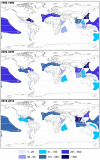Updated Trends on the Biodiscovery of New Marine Natural Products from Invertebrates
- PMID: 35736192
- PMCID: PMC9228037
- DOI: 10.3390/md20060389
Updated Trends on the Biodiscovery of New Marine Natural Products from Invertebrates
Abstract
From 1990-2019, a total of 15,442 New Marine Natural Products from Invertebrates (NMNPIs) were reported. The 2010s saw the most prolific decade of biodiscovery, with 5630 NMNPIs recorded. The phyla that contributed most biomolecules were the Porifera (sponges) (47.2%, 2659 NMNPIs) and the Cnidaria (35.3%, 1989 NMNPIs). The prevalence of these two phyla as the main sources of NMNPIs became more pronounced in the 2010s. The tropical areas of the Pacific Ocean yielded more NMNPIs, most likely due to the remarkable biodiversity of coral reefs. The Indo-Burma biodiversity hotspot (BH) was the most relevant area for the biodiscovery of NMNPIs in the 2010s, accounting for nearly one-third (1819 NMNPIs) of the total and surpassing the top BH from the 1990s and the 2000s (the Sea of Japan and the Caribbean Islands, respectively). The Chinese exclusive economic zone (EEZ) alone contributed nearly one-quarter (24.7%) of all NMNPIs recorded during the 2010s, displacing Japan's leading role from the 1990s and the 2000s. With the biodiscovery of these biomolecules steadily decreasing since 2012, it is uncertain whether this decline has been caused by lower bioprospecting efforts or the potential exhaustion of chemodiversity from traditional marine invertebrate sources.
Keywords: biomolecules; bioprospecting; corals; sponges; zoogeography.
Conflict of interest statement
The authors declare no conflict of interest.
Figures







Similar articles
-
Hydroids (Cnidaria, Hydrozoa) from Mauritanian Coral Mounds.Zootaxa. 2020 Nov 16;4878(3):zootaxa.4878.3.2. doi: 10.11646/zootaxa.4878.3.2. Zootaxa. 2020. PMID: 33311142
-
Trends in the discovery of new marine natural products from invertebrates over the last two decades--where and what are we bioprospecting?PLoS One. 2012;7(1):e30580. doi: 10.1371/journal.pone.0030580. Epub 2012 Jan 20. PLoS One. 2012. PMID: 22276216 Free PMC article.
-
Natural Products from Tongan Marine Organisms.Molecules. 2021 Jul 27;26(15):4534. doi: 10.3390/molecules26154534. Molecules. 2021. PMID: 34361690 Free PMC article. Review.
-
Living Coral Displays, Research Laboratories, and Biobanks as Important Reservoirs of Chemodiversity with Potential for Biodiscovery.Mar Drugs. 2025 Feb 19;23(2):89. doi: 10.3390/md23020089. Mar Drugs. 2025. PMID: 39997213 Free PMC article. Review.
-
Habitat availability and heterogeneity and the indo-pacific warm pool as predictors of marine species richness in the tropical Indo-Pacific.PLoS One. 2013;8(2):e56245. doi: 10.1371/journal.pone.0056245. Epub 2013 Feb 15. PLoS One. 2013. PMID: 23457533 Free PMC article.
Cited by
-
Diversity and Activity of Bacteria Cultured from a Cup-The Sponge Calyx nicaeensis.Mar Drugs. 2024 Sep 26;22(10):440. doi: 10.3390/md22100440. Mar Drugs. 2024. PMID: 39452848 Free PMC article.
-
Antimicrobial, Antioxidant and Anti-Inflammatory Activities of the Mucus of the Tropical Sea Slug Elysia crispata.Molecules. 2024 Sep 27;29(19):4593. doi: 10.3390/molecules29194593. Molecules. 2024. PMID: 39407523 Free PMC article.
-
Antibacterial Methyl Ester Cembranoids from the Soft Coral Sarcophyton ehrenbergi and Their Structural Elucidation.Mar Drugs. 2025 Apr 15;23(4):170. doi: 10.3390/md23040170. Mar Drugs. 2025. PMID: 40278291 Free PMC article.
-
Whole genomes of deep-sea sponge-associated bacteria exhibit high novel natural product potential.FEMS Microbes. 2023 Feb 22;4:xtad005. doi: 10.1093/femsmc/xtad005. eCollection 2023. FEMS Microbes. 2023. PMID: 37333438 Free PMC article.
-
Aquatic Invertebrate Antimicrobial Peptides in the Fight Against Aquaculture Pathogens.Microorganisms. 2025 Jan 14;13(1):156. doi: 10.3390/microorganisms13010156. Microorganisms. 2025. PMID: 39858924 Free PMC article. Review.
References
-
- Calado R., Leal M.C., Gaspar H., Santos S., Marques A., Nunes M.L., Vieira H. How to succeed in marketing marine natural products for nutraceutical, pharmaceutical and cosmeceutical markets. In: Rampelotto P.H., Trincone A., editors. Grand Challenges in Marine Biotechnology. Springer International Publishing; Cham, Switzerland: 2018. pp. 317–403.
-
- Buck M., Hamilton C. The Nagoya Protocol on Access to Genetic Resources and the Fair and Equitable Sharing of Benefits Arising from Their Utilization to the Convention on Biological Diversity. Rev. Eur. Comp. Int. Environ. Law. 2011;20:47–61. doi: 10.1111/j.1467-9388.2011.00703.x. - DOI
Publication types
MeSH terms
Substances
Grants and funding
LinkOut - more resources
Full Text Sources
Research Materials

